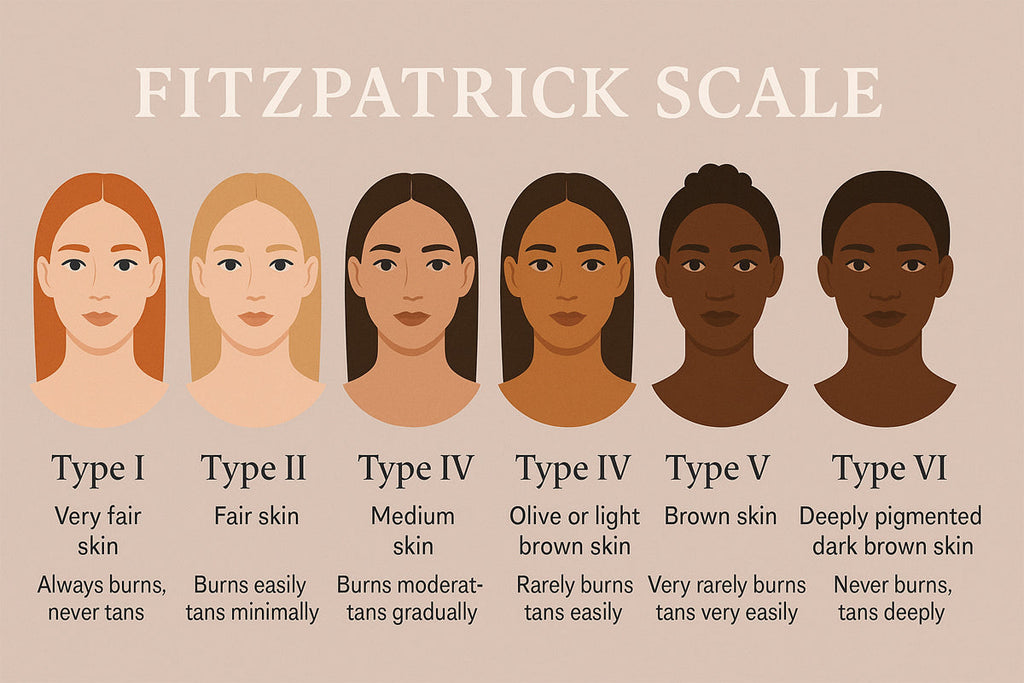
Understanding the Fitzpatrick Scale
The Fitzpatrick Skin Type Scale, developed by Harvard dermatologist Dr. Thomas B. Fitzpatrick in 1975, remains a foundational tool in dermatology and clinical esthetics. Originally designed to assess how skin reacts to ultraviolet (UV) light, it primarily aimed to predict sunburn risk and optimize phototherapy dosing for conditions like psoriasis.
The scale categorizes skin into six types based on a person's propensity to burn or tan:
| Type | Characteristics | UV Response |
|---|---|---|
| I | Very fair skin, often red or blond hair, blue/green eyes | Always burns, never tans |
| II | Fair skin, light eyes and hair | Burns easily, tans minimally |
| III | Medium skin, darker hair | Burns moderately, tans gradually |
| IV | Olive or light brown skin | Rarely burns, tans easily |
| V | Brown skin | Very rarely burns, tans very easily |
| VI | Deeply pigmented dark brown to black skin | Never burns, tans deeply |
Clinically, the Fitzpatrick Scale guides decisions regarding:
- Sun protection counseling
- Skin cancer risk stratification
- Laser, light, and energy-based treatment planning
- Selection of cosmetic interventions like chemical peels
Scientific Limitations of the Fitzpatrick Scale
1. Original Population Bias
The Fitzpatrick model was initially validated using data predominantly from Caucasian populations. Its focus on burning and tanning does not fully reflect the photobiological behavior of deeper skin tones, which may experience different patterns of UV damage, not necessarily characterized by burning.
2. Oversimplification of Melanin-Rich Skin Diversity
The Fitzpatrick Scale reduces the complexity of melanin-rich skin into only two categories (Types V and VI), despite wide biological variation among:
- African
- Afro-Caribbean
- South Asian
- Southeast Asian
- Middle Eastern
- Latin American populations
Factors such as background genetics, cultural sun exposure patterns, and skin behavior under UV stress are not fully captured.
3. Inadequate Assessment of Pigmentary Disorders
Melanin-rich skin is less prone to burning, but highly susceptible to:
- Post-inflammatory hyperpigmentation (PIH)
- Melasma
- Hypopigmentation and dyschromia after procedures
The Fitzpatrick Scale does not predict the risk of pigment alteration—a primary clinical concern for darker-skinned patients undergoing aesthetic or therapeutic interventions.
4. Risks with Laser and Device-Based Treatments
While the scale helps adjust laser settings, relying solely on Fitzpatrick typing can result in thermal injury, scarring, and pigmentary complications in melanin-rich skin.
Deeper skin types often require:
- Lower fluences
- Longer pulse durations
- Selective wavelength choices (e.g., Nd:YAG 1064 nm lasers)
Understanding skin behavior beyond Fitzpatrick typing is now considered best practice in device-based aesthetics.
5. Limited Consideration of Genetic and Environmental Factors
Modern skin science recognizes that UV sensitivity and skin aging are influenced not only by pigment, but also by:
- DNA repair mechanisms
- Melanin type (eumelanin vs. pheomelanin)
- Environmental adaptations
Two individuals with similar skin tones may exhibit different reactions to sun, lasers, and inflammation—complexities the Fitzpatrick Scale cannot distinguish.
6. Underrepresentation in Sun Safety Education
Relying on Fitzpatrick can inadvertently perpetuate myths, such as:
- "Darker skin doesn’t need sunscreen" (it does, for protection against pigmentation changes, photoaging, and skin cancers like acral melanoma)
- "Melanin-rich skin is immune to UV damage" (it is not)
Educational gaps persist because of an overreliance on a model that was never built to reflect global skin diversity.

Moving Beyond Fitzpatrick: Toward Inclusive Skin Typing
While the Fitzpatrick Scale remains a useful starting point, newer frameworks and techniques are being integrated to address its shortcomings:
| Emerging Models | Key Features |
|---|---|
| Glogau Scale | Incorporates aging and photoaging severity across all skin types |
| Taylor Hyperpigmentation Scale | Evaluates pigmentary disorders in darker skin |
| Individual Typology Angle (ITA) | Uses colorimetric analysis for objective skin color assessment |
| MASI (Melasma Area and Severity Index) | Quantifies pigmentation severity |
| Genetic Testing Tools | Provide insight into UV response, pigmentation tendencies, and barrier function |
Clinicians and estheticians today are encouraged to layer assessments — combining Fitzpatrick typing with visual examination, clinical history, lifestyle factors, and ethnic background to deliver more personalized and safer care.
Conclusion
The Fitzpatrick Skin Type Scale was a breakthrough in understanding sun sensitivity and remains clinically valuable.
However, its scientific limitations, especially regarding melanin-rich skin, demand that practitioners adopt more nuanced, inclusive, and scientifically current approaches to skin evaluation.
True excellence in skincare and dermatology lies in recognizing that skin behavior is not only a matter of color, but a matter of biology, environment, and individualized history.
